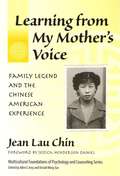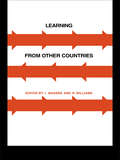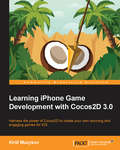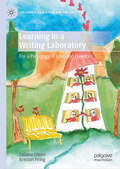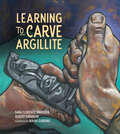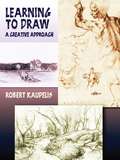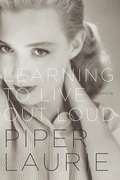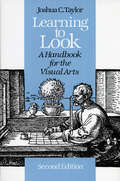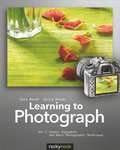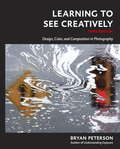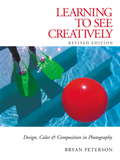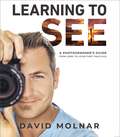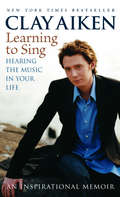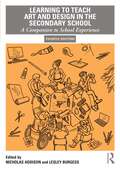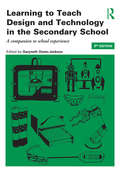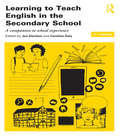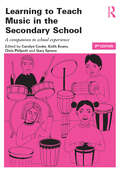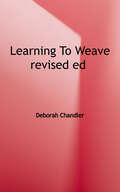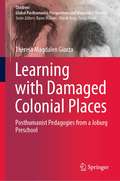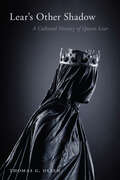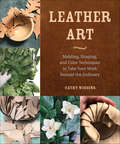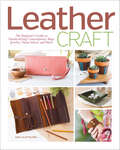- Table View
- List View
Learning from My Mother's Voice: Family Legend and the Chinese American Experience
by Jean Lau Chin"As the reader takes Jean Lau Chin's guided tours through myth and cultural history, it is clear that these stories are more than entertainment: They represent cultural messages about living as a woman. The juxtaposition of Chinese and Western myths with their similarities and differences, followed by the author's incisive analysis of contemporary stories depicting Asian women in print and on the screen, provide culturally driven connections to perceptions and behaviors of Chinese women both individually and in relation to the world. Through these stories, a rich tapestry of information about Chinese women and Chinese American women emerges. The stereotypical Chinese woman fails to appear as the various lenses of ethnicity, gender, location, and epoch make explicit the diversity that exists within any ethnic group and liberate us by providing an informed array of images and possibilities." From Book
Learning from Other Countries: The Cross-National Dimension in Urban Policy Making
by Ian Masser and Richard WilliamsLooking at the lessons we can learn from international research in urban and regional planning, this book explores the challenges in using cross-country studies. The contributors address how to approach researching planning in other countries, and how to then diffuse the planning information. Key topics include: comparable urban data, and how to use it working with international agencies methodological issues in cross-country research translating theory into practice Case studies include researching new towns in France and Poland, and problems doing empirical work in Eastern Europe.
Learning from the Japanese City: Looking East in Urban Design (Planning, History and Environment Series)
by Barrie SheltonJapanese cities are amongst the most intriguing and confounding anywhere. Their structures, patterns of building and broader visual characteristics defy conventional urban design theories, and the book explores why this is so. Like its cities, Japan’s written language is recognized as one of the most complicated, and the book is unique in revealing how the two are closely related. Set perceptively against a sweep of ideas drawn from history, geography, science, cultural and design theory, Learning from the Japanese City is a highly original exploration of contemporary urbanism that crosses disciplines, scales, time and space. This is a thoroughly revised and much extended version of a book that drew extensive praise in its first edition. Most parts have stood the test of time and remain. A few are replaced or removed; about a hundred figures appear for the first time. Most important is an entirely new (sixth) section. This brings together many of the urban characteristics, otherwise encountered in fragments through the book, in one walkable district of what is arguably Japan’s most convenient metropolis, Nagoya. The interplay between culture, built form and cities remains at the heart of this highly readable book, while a change in subtitle to Looking East in Urban Design reflects increased emphasis on real places and design implications.
Learning iPhone Game Development with Cocos2D 3.0
by Kirill MuzykovThis book is an easy-to-follow, step-by-step beginner's guide covering the full process of creating a game. It is packed with examples and illustrations, with comprehensive coverage of each topic. If you want to learn how to make games using the Cocos2D framework, this book is for you. If you would like to build a good foundation for a career in game development as an independent game developer or at a game studio, or if you just want to make games as a hobby, then you'll love this book. You should have some basic programming experience with Objective-C and Xcode. To run the code in this book, you will also need an Intel-based Macintosh running OS X Mountain Lion (or later).
Learning in a Writing Laboratory: For a Pedagogy of Love and Freedom (Creativity, Education and the Arts)
by Tatiana Chemi Kristian FiringThis book is an exploration of a collective writing laboratory designed to stimulate creativity and critical reflection for education professionals. The authors uncover how a writing lab can help educators develop their teaching practices and identities by means of critical-creative, collaborative, relational and arts-based methodologies. A theoretical insight into pedagogies of love and freedom illustrating how laboratory practices in education can become acts of daily care, the book will appeal to students and scholars of education, arts-based methods and creativity.
Learning to Carve Argillite (Sk'ad'a Stories Series)
by Robert Davidson Sara Florence DavidsonBased on Haida artist Robert Davidson's own childhood experiences, this beautiful story highlights learning through observation, as well as the role of Elders in sharing knowledge and mentorship.Learning to carve is a lifelong journey. With the help of his father and grandfather, a boy on Haida Gwaii practises to become a skillful carver. As he carefully works on a new piece, he remembers a trip to Slatechuck Mountain to gather the argillite, as well as his father&’s words about the importance of looking back to help us find our way.Written by the creators of Potlatch as Pedagogy, this book brings the Sk'ad'a Principles to life through the art of Janine Gibbons.
Learning to Carve Argillite (Sk'ad'a Stories Series)
by Robert Davidson Sara Florence DavidsonBased on Haida artist Robert Davidson's own childhood experiences, this beautiful story highlights learning through observation, as well as the role of Elders in sharing knowledge and mentorship.Learning to carve is a lifelong journey. With the help of his father and grandfather, a boy on Haida Gwaii practises to become a skillful carver. As he carefully works on a new piece, he remembers a trip to Slatechuck Mountain to gather the argillite, as well as his father&’s words about the importance of looking back to help us find our way.Written by the creators of Potlatch as Pedagogy, this book brings the Sk'ad'a Principles to life through the art of Janine Gibbons.
Learning to Draw: A Creative Approach (Dover Art Instruction)
by Robert KaupelisTeachers, students, and amateur artists will all benefit from the advice of this esteemed educator and fine artist whose book, as described by a colleague, is "a cause célèbre for art education, not only because it meets the urgent professional need, but also because it combines artistic, aesthetic, and instructional considerations in a way which is significantly different from any other text."Encouraging teachers and students to use his suggestions in ways they feel most appropriate, the author (an expert guide and teacher) offers sound advice on methods and techniques for artists at all levels. Using the lessons and methods he employed over the years as an instructor, Kaupelis focuses on solving the problems common to many illustrators, among them successfully developing perspective, contour and modeled drawing, and drawing from memory and projected images. A splendid blend of instruction, analysis, and insights, this volume--one of the most widely read art instruction texts--deserves a place on the shelves of instructors and serious students of art.
Learning to Live Out Loud: A Memoir
by Piper LaurieAn intimate memoir by three-time Oscar nominee Piper Laurie, one of Hollywood's most gifted and respected actressesAt the age of seventeen, in the glory days of movie-making, Piper Laurie was living every little girl's dream. Having been selected by Universal Studios to be a contract star, Piper was removed from her acting class and provided with stylists, chaperones, leading roles, and handsome dates, and elevated to the heights of Hollywood. Her beauty was admired by the likes of Ronald Reagan, Howard Hughes, Paul Newman, Tony Curtis, as well as dozens of directors and legions of fans. Her name was emblazoned on marquees across America for hit movies of the fifties such as the The Prince Who Was a Thief, The Mississippi Gambler, and Ain't Misbehavin'. But Piper discovered early on that the little girl's dream was not her own. Mortified by the shallowness of the roles and movies she was given, she longed for the freedom and fulfillment of her own artistic vision. After years in the studio system, shy Piper Laurie found her voice and the courage to burn her contract. It was only after she left the oppressive studio culture that she began to star in the TV shows, plays, and films that truly became the hallmarks of her career: The Glass Menagerie on Broadway, the original Days of Wine and Roses, The Hustler, the iconic Carrie, and Twin Peaks. She grew into a three-time Oscar-nominated actress, an accomplished sculptor, and a director. This memoir is the inspiring tale of Piper's perseverance to break from tradition and to practice her craft at the highest level. She started life as a withdrawn, mute child who couldn't find her voice and was transformed into a woman who learned to live out loud by her own rules.From the Hardcover edition.
Learning to Look: A Handbook for the Visual Arts, Second Edition
by Joshua C. TaylorSometimes seeing is more difficult for the student of art than believing. Taylor, in a book that has sold more than 300,000 copies since its original publication in 1957, has helped two generations of art students "learn to look. " This handy guide to the visual arts is designed to provide a comprehensive view of art, moving from the analytic study of specific works to a consideration of broad principles and technical matters. Forty-four carefully selected illustrations afford an excellent sampling of the wide range of experience awaiting the explorer. The second edition of Learning to Look includes a new chapter on twentieth-century art. Taylor's thoughtful discussion of pure forms and our responses to them gives the reader a few useful starting points for looking at art that does not reproduce nature and for understanding the distance between contemporary figurative art and reality.
Learning to Photograph - Volume 2
by Georg Banek Cora BanekThe two volumes of the Learning to Photograph series give students and interested amateur photographers essential information about technique and design as well as an understanding of the big concepts of photography. Beginning and advanced photographers alike will find the content instructive, thoroughly explained, and effectively illustrated, making this book a useful resource for readers to develop their own craft. This second volume addresses the topics of visual design and composition. The authors describe various methods of visual design and how you can use these methods effectively. You will learn which techniques to use to design your images while at the same time training your photographic eye. You will develop the ability to support the message of your subject purposefully, hone your photographic style, and analyze your own work and the work of others competently. The striking images and informational graphics not only illustrate the concepts at hand, but also make the lessons visually pleasing and offer useful examples for readers to mimic in their own work. Topics include: Visual perception Composition, shapes, and lines Managing light Color and its effects Sharpness, blur, and movement The interplay of visual design elements Image analysis and evaluation The previous volume in the Learning to Photograph series addresses cameras, equipment, and basic photographic techniques.
Learning to See Creatively, Third Edition
by Bryan PetersonCompletely revised and updated throughout, Bryan Peterson's classic guide to creativity helps photographers visualize their work, and the world, in a whole new light by developing their photographic vision. Fully revised with 100 percent new photography, this best-selling guide takes a radical approach to creativity by explaining how it is not just an inherent ability but a skill that can be learned and applied. Using inventive photos from his own stunning portfolio, author and veteran photographer Bryan Peterson deconstructs creativity for photographers. He details the basic techniques that go into not only taking a particular photo, but also provides insights on how to improve upon it--helping readers avoid the visual pitfalls and technical dead ends that can lead to dull, uninventive photographs. This revised edition features a complete section on color as a design element and all new photographs to illustrate Peterson's points. Learning to See Creatively is the definitive reference for any photographer looking for a fresh perspective on their work.
Learning to See Creatively: Design, Color and Composition in Photography (Revised Edition)
by Bryan PetersonAlmost everyone can "see" in the conventional sense, but developing photographic vision takes practice. Learning to See Creatively helps photographers visualize their work, and the world, in a whole new light. Now totally rewritten, revised, and expanded, this best-selling guide takes a radical approach to creativity. It explains how it is not some gift only for the "chosen few" but actually a skill that can be learned and applied. Using inventive photos from his own stunning portfolio, author and veteran photographer Bryan Peterson deconstructs creativity for photographers. He details the basic techniques that went into not only taking a particular photo, but also provides insights on how to improve upon it--helping readers avoid the visual pitfalls and technical dead ends that can lead to dull, uninventive photographs. This revised edition features the latest information on digital photography and digital imaging software, as well as an all-new section on color as a design element. Learning to See Creatively is the definitive reference for any photographers looking for a fresh perspective on their work. * Updated to include digital * All new artwork, and a totally revised and expanded text * All-new section on color as a design element.
Learning to See: A Photographer’s Guide from Zero to Your First Paid Gigs
by David MolnarWhether you want to take better photos in your everyday life or make a full-time income as a photographer, the five-part framework author David Molnar teaches in Learning to See will work for you:See: have a vision for your shot and execute that visionShoot: become technically proficient with your cameraEdit: help re-create the emotion from the day of the shootDevelop: identify your area of focus for photographyEarn: start getting paid for your artIt&’s a proven process every photographer follows but few talk about. But if you use it, it will shave years off the learning curve he himself went through as an amateur photographer. This book teaches readers to learn to see, because in the end, that&’s what a photographer does: notice what other people often miss and understand how to capture those things in a masterful way.
Learning to Sing: Hearing the Music in Your Life: An Inspirational Memoir
by Clay AikenIn Learning to Sing, Clay Aiken tells the story of how his faith was integral to him learning valuable life lessons during his meteoric rise from life as an aspiring educator in Raleigh, North Carolina to instant stardom on "American Idol. " Clay's advice is 1) Believe in yourself, 2) Believe in God, and 3) Be really stubborn. This personal relationship with God is key to personal success, as Clay has witnessed in real life experiences. When asked to "dirty up" his lyrics to increase sales, he resisted -- and has sold more than 3 million albums. He refuses to make videos placing him in inappropriate situations, and considers his relationship with God the most valuable in his life. Learning to Sing is an account of Clay Aiken's extraordinary faith and will and perseverance, and an inspiring memoir by someone who became -- against all odds -- one of the biggest pop stars of his time.
Learning to Teach Art and Design in the Secondary School: A Companion to School Experience (Learning to Teach Subjects in the Secondary School Series)
by Nicholas Addison Lesley BurgessLearning to Teach Art and Design in the Secondary School is the key text for all those preparing to become art and design teachers in secondary school. It explores a range of approaches to teaching and learning, and provides a conceptual and practical framework for understanding the diverse nature of art and design in the secondary school curriculum.Written by experts in the field, it aims to inform and inspire, challenge orthodoxies and encourage a freshness of vision. It provides support and guidance for learning and teaching in art and design, suggesting strategies to motivate and engage pupils in making, discussing and evaluating visual and material culture.This fourth edition has been comprehensively updated and re-structured in light of the latest theory, research and policy in the field and includes new chapters exploring diversity, identity and inclusion, attitudes to making and teaching as an artistic practice.Essential topics include: Ways of learning in art and design Teaching as an artistic practice Planning for teaching and learning Diversity and inclusion Sustainable design Assessment and examinations Critical studies Professional development in the gallery Supporting each chapter are suggestions for further reading and tasks designed to encourage you to reflect critically on your practice. Learning to Teach Art and Design in the Secondary School addresses issues for all student teachers and mentors on initial teacher education courses in Art and Design. It is also of relevance and value to teachers in schools with designated responsibility for supervision.
Learning to Teach Design and Technology in the Secondary School: A companion to school experience
by Gwyneth Owen-JacksonLearning to Teach Design and Technology in the Secondary School is established as a core text for all those training to teach Design and Technology in the secondary school. It helps you develop subject knowledge, acquire a deeper understanding of the role, purpose and potential of Design and Technology within the secondary curriculum, and provides the practical skills needed to plan, teach and evaluate stimulating and creative lessons. This third edition has been fully updated in light of the latest curriculum, policy and theory, as well as exciting changes in the field of design and technology.? Designed to be read as a course or dipped into to for support and advice, it covers: Developing areas of subject knowledge Health and safety Planning lessons Organising and managing the classroom Teaching and learning with digital technologies Teaching wider issues through design and technology? Assessment issues Your own professional development. Bringing together insights from current educational theory and the best contemporary classroom teaching and learning, this book will prove an invaluable resource for all student and newly qualified teachers – as well as their mentors - who aspire to become effective, reflective teachers.
Learning to Teach English in the Secondary School: A companion to school experience (Learning to Teach Subjects in the Secondary School Series)
by Jon Davison Caroline DalyHow do you approach teaching English in the contemporary classroom? What is expected of a would-be English teacher? The fourth edition of this best-selling text combines theory and practice to present an indispensable introduction to the opportunities and challenges of teaching English in the secondary classroom. It offers insight into the history, policies and definitions surrounding the subject, together with innovative and practical strategies which can be used for effective teaching and learning. Already a major text for many university teacher education courses, the new edition reflects the extent and impact of current reforms whilst retaining its focus on what is of enduring value for English teaching. With an emphasis on developing your own values and on stimulating approaches that underpin English teaching, it will help you navigate your way through changing curriculum requirements, assessment practice and the demands of professional development. Key topics explored include: Reading, writing and speaking and listening Teaching language and grammar Drama in English teaching Poetry Working with digital technologies Post-16 English language and literature Developing as a critically reflective practitioner. Written particularly with the new and student teacher in mind, Learning to Teach English in the Secondary School aims to equip readers with the tools to make critically informed judgements about how to teach, develop principled practice and most importantly, be mindful of pupils and their experience of English in the secondary classroom.
Learning to Teach Music in the Secondary School: A companion to school experience (Learning to Teach Subjects in the Secondary School Series)
by Carolyn Cooke, Keith Evans, Chris Philpott and Gary SpruceThis 3rd edition of Learning to Teach Music in the Secondary School has been thoroughly revised to take account of the latest initiatives, research and scholarship in the field of music education, and the most recent changes to the curriculum. By focusing on overarching principles, it aims to develop reflective practitioners who will creatively and critically examine their own and others’ ideas about music education, and the ways in which children learn music.Providing an overview of contemporary issues in music teaching and learning from a range of perspectives, the book focuses on teaching music musically, and enables the reader to: place music education in its historical and social context consider the nature of musical knowledge and how teachers can facilitate their students to learn musically critically analyse the frameworks within which music teachers work develop an understanding of composing, performing and responding to music, as well as key issues such as creativity, individual needs and assessment examine aspects of music beyond the classroom and how effective links can be made between curriculum music and music outside of school. Including a range of case studies, tasks and reflections to help student teachers integrate the theory and practice of music education effectively, this new edition will provide invaluable support, guidance and challenges for teachers at all stages of their careers, as well as being a useful resource for teacher educators in a wide range of settings.
Learning to Weave
by Deborah ChandlerOriginally published in 1995, more than 40,000 weavers have used this unparalleled study guide to learn from scratch or to hone their skills. Written with a mentoring voice, each lesson includes friendly, straightforward advice and is accompanied by illustrations and photographs. Crafters need only to approach this subject with a willingness to learn such basics as three methods for step-by-step warping, basic weaving techniques, project planning, reading and designing drafts, the basics of all the most common weave structures, and many more handy hints. Beginners will find this guidebook an invaluable teacher, while more seasoned weavers will find food for thought in the chapters on weave structures and drafting.
Learning with Damaged Colonial Places: Posthumanist Pedagogies from a Joburg Preschool (Children: Global Posthumanist Perspectives and Materialist Theories)
by Theresa Magdalen GiorzaThis book offers a close and detailed account of the emergent and creative pedagogies of children learning together in a small, not-for-profit preschool, and the entangled becomings of their carers as well as the researcher–artist–author. The mutually affecting and inseparable realities of the ‘material’ and the ‘discursive’ are made visible through lively and sensual pedagogical invention by a group of five-year olds in the inner-city preschool which is located in Johannesburg, South Africa. These small, local stories are recognized in their emergence with global geopolitical realities. The author makes a valuable contribution to post-qualitative research through the use of visual research methods and non-representational approaches to working with knowledge. The book draws on the constantly evolving practices of Philosophy for Children (P4C) and Reggio Emilia both as pedagogical tools and as research methods. Photographs and stills from video footage provide a sense of the relatively modest material environment of the school. The book celebrates the considerable richness of the involvement of the children and the enormous possibilities offered by the world both inside and outside of the classroom when an enquiry-led art-based pedagogy is followed. Drawings and other products created by the children in the study offer valuable insight into the depth and complexity of their engagement with their worlds, both individual and collaborative.
Lear’s Other Shadow: A Cultural History of Queen Lear
by Thomas G. OlsenLear’s Other Shadow: A Cultural History of Queen Lear offers a deep cultural analysis of the figure of Queen Lear, who shadows and eventually sometimes overshadows her royal husband across the nearly one-thousand-year life of this archetypal tale. What appears to be a deliberate strategy of suppression, even erasure in Shakespeare’s King Lear later inspired dozens of stage, page, and cinematic remakes and adaptations in which this figure is revived or remembered, often pointedly so. From Jacob Gordin’s Yiddish-language Miriele Efros (1898), through edgy stage remakes such as Gordon Bottomley’s King Lear’s Wife (1915) and the Women’s Theatre Group’s Lear’s Daughters (1987), to novelized retellings from Jane Smiley’s A Thousand Acres (1991) to Preti Taneja’s We That Are Young (2018) and J. R. Thorp’s Learwife (2021), and even the television series Empire (2015–2020) and Succession (2018–2023), Queen Lear regularly emerges from her shadowy origins to challenge how we understand the ancient King Leir/King Lear story. These and many other examples reveal fascinating patterns of adaptation and reinterpretation that Lear's Other Shadow identifies and analyzes for the first time, showing how and why Queen Lear is at the center of this ancient story, whether she is heard from or not.
Leather Art: Molding, Shaping, and Color Techniques to Take Your Work Beyond the Ordinary
by Cathy WigginsA popular designer teaches 18 projects to help turn your basic leather creations into head-turning artistic statementsFor leather crafters who don't need more patterns but instead want to add artistic impact to their workWiggins's leather art is found in high-end homes, museums, and even Las Vegas hotel casinos
Leather Bracelets: Step-by-step instructions for 33 leather cuffs, bracelets and bangles with knots, beads, buttons and charms
by Nihon Vogue-ShaThirty-three easy-to-make designs—from friendship bracelets to a braided metallic cuff. Mix and match to create your own personal style! Make the most of one of today&’s hottest jewelry trends with Leather Bracelets, a collection of thirty-three beautiful beaded, knotted, and braided accessories that would be at home on the shelves of the most stylish designer boutiques. Gorgeous worn alone but even more stylish stacked, these bracelets can be made with readily available leather cord and findings and a few basic jewelry-making tools. Each hand-crafted bracelet can be made unique just by changing the colors and chosen charms or beads. Sized precisely to fit the recipient, these bracelets are sure to please!
Leather Craft: The Beginner's Guide to Handcrafting Contemporary Bags, Jewelry, Home Decor & More
by Amy GlatfelterA classic craft reinvented for the modern maker! Love the luxe look of leather but intimidated by what seems like expensive materials, complex designs, and difficult techniques? Think again! Skilled artisan Amy Glatfelter teaches how to make fifteen gorgeous projects in leather using small cuts of material, easy techniques, and inexpensive tools. From buttery-soft clutches and totes to leather-wrapped planters and stylish jewelry, makers will learn to create a variety of updated classics that get better over time. Perfect for absolute beginners, this book starts with an overview of leather and the tools needed, step-by-step instructions, and ten essential leather crafting techniques. The ultimate beginner’s guide for an accessible and modern approach to leather craft! Step-by-step lessons for the ten essential leather crafting techniques, including how to cut and stitch leather, punch holes, set snaps and rivets and more Create a variety of home décor, jewelry, and personal accessory projects; each project includes detailed instructions, reference photographs, and a pattern
